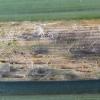
12-11-2025 09:25
 Viktorie Halasu
Viktorie Halasu
Hello, I need help with a pale terrestric Pseudom

11-11-2025 20:16
Bohan JiaHi, lastly I have found these tiny yellow decayin

09-11-2025 13:20
Hello.A tiny ascomycete, appearing as erupting gra

08-11-2025 00:29
 Francois Guay
Francois Guay
I found this species in Quebec, Canada, on herbace
Hello,
I have collected several times a pyrenomycete that keeps me busy. All the collections were made on Phragmites culms.
Perithecia immersed, erumpent. Asci cylindrical 157-179 x 10-11 µm, with a well developed apical pore, amyloid in IKI. Spores 1-septate, dark greenish brown, with a long germ slit in each cell, without gelatinous caps or appendices (no China ink tested), 17-23.5 x 7.5-8.5 µm.
I think it must belong to Amphisphaeriaceae due to its 2-celled pigmented spores and asci with amyloid apparatus, but I fail to find any species with similar spores in the family, especially with those germ slits (which I would say are more typical in Xylariaceae). I compared it first with Cainia griminis, but it has longer spores with several germ-slits at the end of the spores. It keys out in Amphisphaeria according to Barr, but I do not find any species with similar spores in the genus.
Any hint? Anything I might have missed?
Thank you in advance!
Ibai.

Seynesia Sacc. is a possible match, but I am not aware of a species occurring on Phragmites. It is basically a tropical genus occurring on palm and other monocots.
Hope it helps.
Cheers,
Jacques
Thank you Jacques! Yes it helps. The spores appear to be characteristic of Seynesia. I had excluded Xylariaceae because of the 2-celled spores. I will search in Seynesia. You should very probably have this fungus in your area as it is common in the Basque area.
Cheers,
Ibai.

I send you a paper on the three palm species recognized by Hyde so that you can compare it to S. livistonae that has the same ascospore size range.
Good luck!
Jacques
It is very common in this habitat Scirrhia rimosa (Alb. & Schwein.) Fuckel
I hope it would help you in your identification.
Kind regards,
M. Torrejón
Hi Miguel
I don't think this is Scirrhia rimosa, a very different fungus with hyaline ascospores and more complex stromata.
See my card on this site

regards,
björn
Have you made any progress in the description, Ibai?


 Immersed perithecia with an emerging ostiole
Immersed perithecia with an emerging ostiole